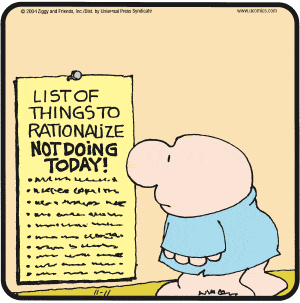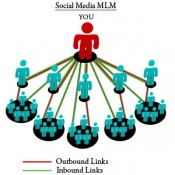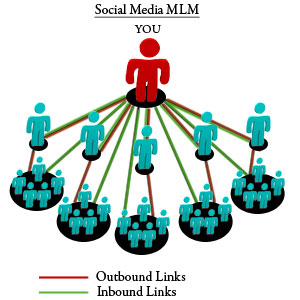BMW gave us The Ultimate Driving Machine. Bounty is the Quicker Picker-upper. Meanwhile, companies like McDonald’s have had innumerable slogans, from I’m Lovin’ It to Put a Smile on. These slogans are memorable because they tell the value proposition of the brand, underscore the company’s mission and speaks these things clearly. If your slogan doesn’t accomplish the preceding then your slogan is terrible. [Read more…]
The Self-Starter
 So, you have a great idea and want to start a business – good for you! Along with everything else you have to worry about (products, marketing, accounting, employees, profitability) you also need to beware of the hidden entrepreneurial danger. It lurks in the shadowy depths of good meetings, hot ideas and the expertise of others. It’s lack of follow through and general apathy.
So, you have a great idea and want to start a business – good for you! Along with everything else you have to worry about (products, marketing, accounting, employees, profitability) you also need to beware of the hidden entrepreneurial danger. It lurks in the shadowy depths of good meetings, hot ideas and the expertise of others. It’s lack of follow through and general apathy.
It’s easy to cure your own apathy, especially when paychecks rely on project and task completion. The true self-starter is able to get others, that show less urgency, to operate on a schedule consistent with their needs. Beware of your partners and suppliers holding up the show. If you want to be great, you’ll learn how to manage those relationships to work with the timetables that are needed for your business to be successful. It stinks, I know, because managing personal behavior is difficult enough – let alone someone else’s. But trust me, it’s necessary.
I believe it was Ben Franklin that said, “expect the worst and be pleasantly surprised when it doesn’t happen.” If we were in church I’d be yelling preach. But we’re not so I’ll yell chuuch to ol’ Bennie F. What he says (or what I think he says) makes fantastic sense. Instead of being happy when it doesn’t happen, though, I’ve decided to proactively start to sit on vendors like park benches. It’s not fun and I’d much rather allow people to do what they say they’re going to do, when they say they’re going to do it. Unfortunately, it’s rare when that happens.
Setting up a process for managing the completion of projects when most effective for your peak profitability is key. Part of that strategy may be managing the behavior of a partner/vendor/employee to get things done in the way and time your business needs.
It’s funny, we (me included) are often talking about Customer Relationship Management tools. Sometimes I feel like we need a Business Relationship Management tool, to effectively manage communications with our business partners.Seriously, this idea could save a business or three. I wonder who can help me get this launched? Hmmmm…
Inquiring minds want to know – do you have any tips for managing relationships and keeping people on task?
3 CRM Tricks to Build Loyalty
Statistics show it takes 60% more effort, money, time, et al to create a new customer. It’s like making a new friend. You have to figure out what you like to do together and whether or not they’ll be dependable. You have to put in some serious effort to let them know that you care. Meanwhile, your friendships that you’ve had a while continue to be of great value by simply proving loyal on a regular basis. Building a business is the same way. Here are some ways that you can utilize a friendship strategy with your customers.
Invite them over for special events
What better way to enjoy the company of your friends and inspire loyalty than to host them? When I say host, I mean provide something at your place that allows them to socialize and enjoy the fact that you’re all connected. Business people would say provide some added value. You never know what kind of value one can derive from a small investment, so invest in the people that support you! In only makes logical sense.
To do this, you’ll have to put processes in place that allow you to track who is regularly visiting and purchasing. Try opt-in email and mobile strategies like rewards programs. Give customers the option to sign up in-store or online. I like Place Pop as a mobile and web loyalty/rewards application program. It provide great flexibility and convenience for the business and the customer.
Offer suggestions that will be useful
Ever see something and immediately think of a friend that something would “be perfect for”? I love cigars, and recently had a friend send me a text message about Romeo y Julieta’s on sale at the JR Cigar near my job. I was so thankful, that I’m sure to hook him up with a “stick” when I see him next.
Since you’re capturing purchases, utilize that information to make suggestions or let all purchasers of a certain product know when it goes on sale. The loyalty that can be created by this simple act can be more valuable than waterproof boots in a snowstorm.
Ask Customer Opinion
People have always utilized their friends for advice – from love and relationships to companies and products. Why not leverage this bonding experience based upon the art of pontification, to make a friend out of your customers? Plus, who doesn’t love to be on the inside? So, pull your customers in to the proverbial fold, or circle of trust if you will, by seeking advice about how to make their experience better. You might shock them into becoming extraordinarily loyal, and that’s all we want.
Adversarial relationships rarely work, so create some loyalty by forming friendly relationships with your best customers by using the help of a customer relationship management tool. Your customers will thank you, and so will your margins.
Online Advertising: The Truth Shall Set You Free!
Yes, it is true. While I don’t claim ministerial prowess or even great oration skills, I do know a truth when I hear/read one – whether from the pulpit or the pdf. Delivering truth is the situation the digital advertising industry currently faces. How, you ask? If you haven’t noticed, there is an onslaught of negative press and backlash about what digital marketers are collecting regarding online behavior; personally identifiable information; how their creating target audiences and which companies are “going too far.”
a truth when I hear/read one – whether from the pulpit or the pdf. Delivering truth is the situation the digital advertising industry currently faces. How, you ask? If you haven’t noticed, there is an onslaught of negative press and backlash about what digital marketers are collecting regarding online behavior; personally identifiable information; how their creating target audiences and which companies are “going too far.”
One only need go to the Wall Street Journal to read an article of carefully crafted and curiously self-omitting half truths about what the industry is about and why advertisers feel the need to gather information about online behavior. Many of the articles, interviews and generally accepted myths I’ve read and heard have been not only off base but close to fear-mongering. As an online advertising industry, of which automotive represents roughly 10%, we have done a poor job of getting ahead of the story with education and transparency. We all know what follows lack of understanding…fear.
One of my favorite organizations, the IAB, has done some good work putting together a document that proposes we self-regulate the industry and educate the constituents. It can be found on their website, under ‘Self Regulatory Principles for Online Behavioral Advertising.’ There are 7 tenets (they call them principles) that we all on the data and customer facing sides of the industry should follow. They are:
- The Education Principle
- The Transparency Principle
- The Consumer Control Principle
- The Data Security Principle
- The Material Changes Principle
- The Sensitive Data Principle
- The Accountability Principle
To learn more about each, and see how they are proposed to be put in to practice please click on the above link to the document. The most important thing we can do to keep the internet a place where people can inexpensively exchange ideas, is to bring relevant advertising content. Without ad dollars, the internet will lose some of its egalitarianism, creativity, and public support so we must all do our part to make sure it continues to grow unfettered by complicated pay-for-content models.
I’m proposing each advertiser take a good look at what they can do to increase education in an effort to reduce fear. Once people learn about what is actually being done by reputable companies, they see much less need to worry and regulate a growing industry designed to bring the most relevant content to the eyes of web surfers. As long as you heard me I’m stepping off of my soapbox.
Direct-Response Digital – Mobile
You may have thought that the direct-response digital series had lost some steam. Au contriare, mon frere. There have been some technical difficulties at the Hand Raiser offices, but Ryan Meray at C! Tech Solutions got us back in the game…we’ll be at 100% capacity soon – but I digress. The real reason we’re here is because I want to talk about mobile. While thinking of ideas for this topic, I was serendipitously introduced to this eMarketer article in my Twitter stream. I am so lucky sometimes, people might confuse it as good.
In brief, the article states that mobile banners out perform standard banners in Click-Through Rates (CTR) and Conversion. In fact, for rich media formats (like floating ads and commercial breaks) the metrics on mobile double up standard web ads in the positive column. Everyone – including myself – have been predicting mobile to blow up like a smoker at a gas station for the past couple of years. It has not happened. At least not yet, that is.
Statistics such as the ones in the eMarketer article suggest that the proverbial shark should be jumped very soon. Total smartphone purchase intent, as represented in the following chart, is at an all-time high of 16.4% according to Change Wave Research. With 52% of those surveyed planning on buying an iPhone, the iAd purchase of Quattro means solidarity among that ad platform. Plus, their $148 Earnings per Thousand (in some instances) number doesn’t hurt either. Android, the other big market share winner doesn’t realize as high of a return on the AdMob platform they run, but I think it is coming soon.
So, if you follow the money it is clear that demand from advertisers and app developers will be there soon. Why? It all comes down to purchase intent study. Whether it is SMS, mobile video, or mobile ads purchase intent is higher on mobile/smartphone devices than online in almost every category, says Mobile Marketer.
Not until recently have I seen data this compelling. Between the growth of smartphone purchase (where most of the mobile ads and purchase decisions are made) and the high dollar opportunities for brands, advertisers, and app developers alike – the explosion is as inevitable as death and taxes.
My recommendation to you, Mr./Mrs. Small Business Owner, is if you’re thinking about getting into mobile do so now. The benefits realized from a quality direct-response campaign could be colossal. Just make sure that your program is integrated with the rest of your messages (as I will always tell you) because ad awareness, brand awareness, and acceptance are all raised with smart, relevant and well targeted mobile campaigns.
If you’re already using mobile, what ad platform do you use? Have you found one OS to be more or less effective for your products?








Follow Us!